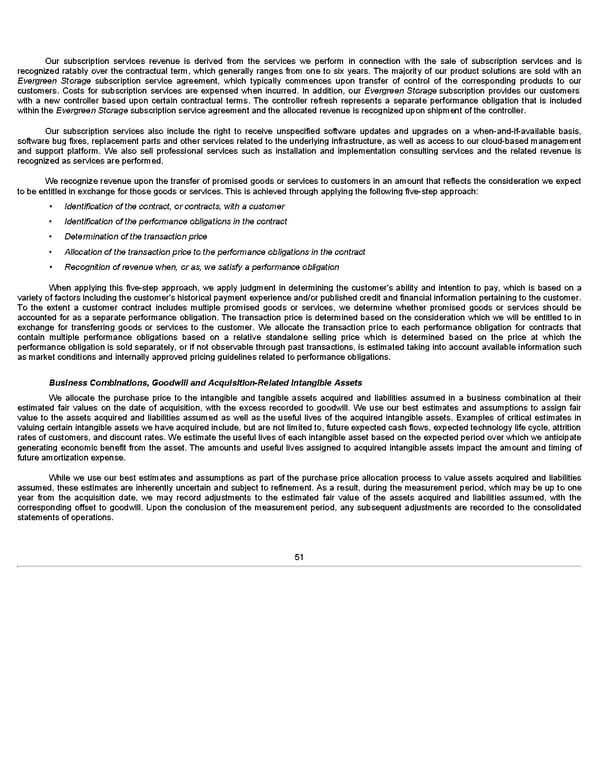Our subscription services revenue is derived from the services we perform in connection with the sale of subscription services and is recognized ratably over the contractual term, which generally ranges from one to six years. The majority of our product solutions are sold with an Evergreen Storage subscription service agreement, which typically commences upon transfer of control of the corresponding products to our customers. Costs for subscription services are expensed when incurred. In addition, our Evergreen Storage subscription provides our customers with a new controller based upon certain contractual terms. The controller refresh represents a separate performance obligation that is included within the Evergreen Storage subscription service agreement and the allocated revenue is recognized upon shipment of the controller. Our subscription services also include the right to receive unspecified software updates and upgrades on a when-and-if-available basis, software bug fixes, replacement parts and other services related to the underlying infrastructure, as well as access to our cloud-based management and support platform. We also sell professional services such as installation and implementation consulting services and the related revenue is recognized as services are performed. We recognize revenue upon the transfer of promised goods or services to customers in an amount that reflects the consideration we expect to be entitled in exchange for those goods or services. This is achieved through applying the following five-step approach: • Identification of the contract, or contracts, with a customer • Identification of the performance obligations in the contract • Determination of the transaction price • Allocation of the transaction price to the performance obligations in the contract • Recognition of revenue when, or as, we satisfy a performance obligation When applying this five-step approach, we apply judgment in determining the customer's ability and intention to pay, which is based on a variety of factors including the customer's historical payment experience and/or published credit and financial information pertaining to the customer. To the extent a customer contract includes multiple promised goods or services, we determine whether promised goods or services should be accounted for as a separate performance obligation. The transaction price is determined based on the consideration which we will be entitled to in exchange for transferring goods or services to the customer. We allocate the transaction price to each performance obligation for contracts that contain multiple performance obligations based on a relative standalone selling price which is determined based on the price at which the performance obligation is sold separately, or if not observable through past transactions, is estimated taking into account available information such as market conditions and internally approved pricing guidelines related to performance obligations. Business Combinations, Goodwill and Acquisition-Related Intangible Assets We allocate the purchase price to the intangible and tangible assets acquired and liabilities assumed in a business combination at their estimated fair values on the date of acquisition, with the excess recorded to goodwill. We use our best estimates and assumptions to assign fair value to the assets acquired and liabilities assumed as well as the useful lives of the acquired intangible assets. Examples of critical estimates in valuing certain intangible assets we have acquired include, but are not limited to, future expected cash flows, expected technology life cycle, attrition rates of customers, and discount rates. We estimate the useful lives of each intangible asset based on the expected period over which we anticipate generating economic benefit from the asset. The amounts and useful lives assigned to acquired intangible assets impact the amount and timing of future amortization expense. While we use our best estimates and assumptions as part of the purchase price allocation process to value assets acquired and liabilities assumed, these estimates are inherently uncertain and subject to refinement. As a result, during the measurement period, which may be up to one year from the acquisition date, we may record adjustments to the estimated fair value of the assets acquired and liabilities assumed, with the corresponding offset to goodwill. Upon the conclusion of the measurement period, any subsequent adjustments are recorded to the consolidated statements of operations. 51
 Annua lReport Page 50 Page 52
Annua lReport Page 50 Page 52